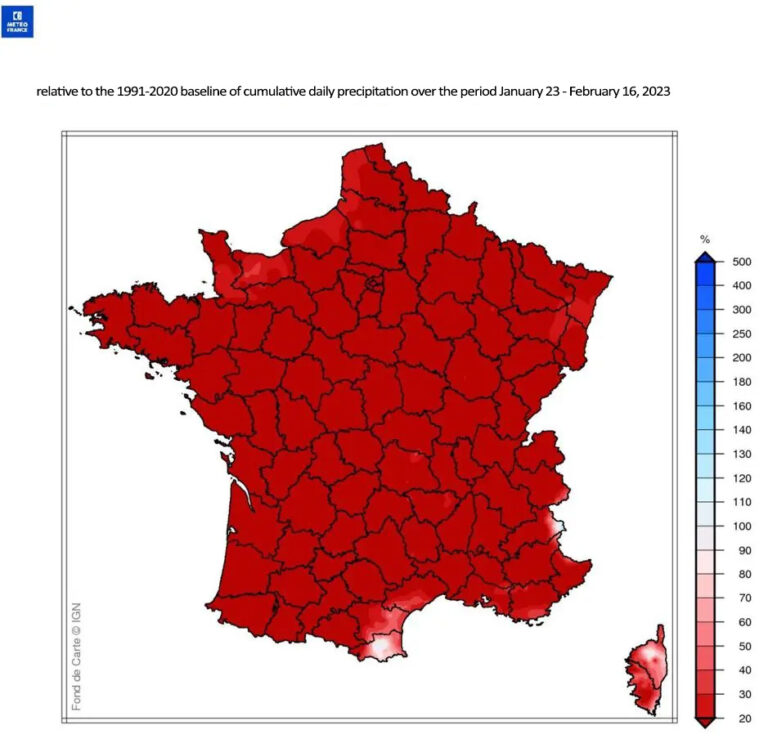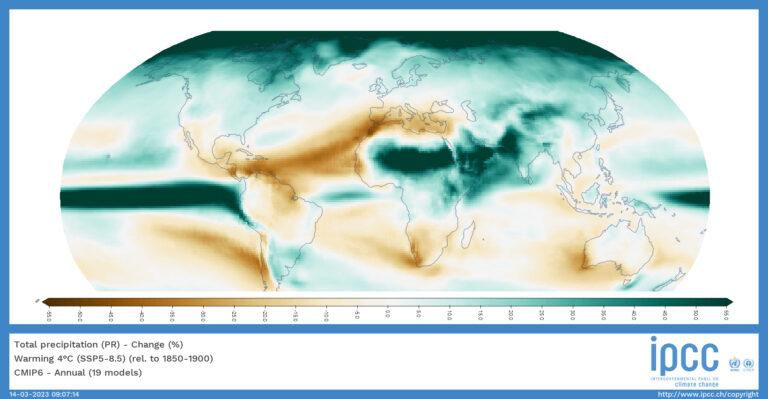Adapting to a changing climate : water resources
During the winter of 2022-2023, France went through a severe drought, counting 32 days without rain. The last winter record was 22 days without rain in 1989.
Late February, soil conditions were drier than usual, comparable to the conditions usually encountered in mid-April; Namely 2 months ahead of schedule.
In the context of climate change, such droughts will become greater and more frequent; it is reasonable to ask ourselves : how should our society anticipate this new risk ? Which sectors are mostly impacted ? How can we tackle this issue ?

Drought : a meteorological event worsened by climate change
Drought is an occasional lack of water, long or short, but sufficient to affect the soil and flora. This phenomenon can be cyclic or exceptional, and has various consequences : rivers dewatering, ecosystem disruption, freshwater depletion, increase in the risk of fire.
France has experienced several historical droughts. Out of the 8 most significant ones in the last 100 years, 4 took place during the period 1921-2000 and 4 during the period 2000-2022.
Different kinds of droughts exist :
- Meteorological droughts : when the level of precipitations is below average over long periods;
- Agricultural droughts : characterized by soil water deficiency, depend on precipitation, wind, air temperature parameters and also on the type of plants in the soil.
- The last category is the hydrological drought, with reduced streamflow, reduced inflow to reservoirs, lakes, and groundwater; it reduces wetlands, and impacts wildlife habitat.
How can we explain this deficiency of precipitation and disruption of the water cycle?
All begins with the additional greenhouse gases (GHG) emitted through human activities. Released in the atmosphere, they remain there for centuries. GHG molecules have the physical ability to absorb and re-emit some of the infrared radiation emitted by the Earth’s surface, warming up the Earth’s surface and the lower atmosphere. In a way, these molecules act like a coat that prevents your body’s heat from being lost into the outside, and prevents you from getting cold. This is called the additional greenhouse effect, due to human activities.
Because of this increasing CO2 concentration, the Earth’s surface temperature is warming up (already, +1.2°C since 1850). As the air warms, its capacity for holding water vapor increases (+7% per degree). You can observe this in your bathroom after taking a shower : Close to the window, where the air is cooler, the water vapour condenses.
Oceans are also warming up because of this additional greenhouse effect. The world’s surface water temperature has increased by +0.8°C since 1880 according to the NOAA. As the water temperature increases, more water evaporates into the atmosphere.
Air and water temperatures are 2 key parameters for the Earth’s water cycle. This cycle remained stable for about 10 000 years, time during which the climate was also stable.

In France, droughts are more and more frequent. According to climate model predictions, they are going to last in the south of France. In the meantime, the variability in precipitation rises : It rains heavily over short intervals of time and then it does not rain for long periods of time.
As the air warms, its capacity for holding water vapor increases (+7% per degree).
Droughts worsened by other phenomena.
Particularly heatwaves, with lasting high temperatures that accentuate water evaporation in the soil. Also high winds, acting like a hair-dryer on the soils. Then, when soils are dry, they have a much harder time absorbing water from rainfall. It is referred to as ineffective rainfall because the water runs off into rivers and is discharged into the oceans without hydrating the soil and recharging the aquifers.
Global warming is weakening the renewal of freshwater stocks available for spring and summer. Indeed, the limit of rain-snow is getting higher and higher in altitude, and winters are getting warmer and warmer, limiting snowfall. As a result, rivers benefit from less snowmelt in spring and summer, further aggravating the above phenomena.
In short, water availability useful for human activities depends on :



Droughts are impacting our economic activities!
Humanity has thrived on Earth thanks to water. Water is paramount for the development of life : The human body is made up of 80% water. A human being can survive several tens of days without eating but only 3 days without drinking. Not only water is a vital resource for the living species that we are, but also for the economic activities that underlie our societies. Climate change is reshuffling the cards of the way our societies are run and why, particularly in the use of water resources.
France is the first tourist country in the world, is a net wheat exporter, and counts a large fleet of nuclear power plants. These three sectors are and will be more impacted by the depletion of water resources. Let’s see how.
In France, the first sector in water consumption is agriculture, consuming 45% of the volume. You can also find different statistics where the energy sector is in 1st place with 50% of the volume withdrawn. But there, the volumes were withdrawn and then given back to the environment.
Knowing that agriculture represents 45% of the water consumption, if the territory suffers from more and more intense droughts,agriculture will be impacted.
The consequences of droughts on agriculture will be multiple, and as intense as unprepared : Dry soils in the spring make it more difficult to sow. Dry soils also make pastures less green and storing forage more difficult. Last but not least, animals may be slaughtered for lack of water or food. A dairy cow drinks up to 100 L of water per day, not counting the water needed to grow its own food.
France has a very rich environmental heritage with many diverse biomes. Climate change impacts these natural biomes in different ways. For example, due to the increased Mediterranean sea temperature, the Mediterranean coastline is more and more invaded by jellyfish.
Other biomes suffer from water deficiency : During the summer of 2022, in the magnificent “Gorges du Verdon”, water activities such as rafting were canceled. This caused a decrease in attendance by 10%. Last but not least, during the summer of 2022, France experienced many megafires, eased by the dryness of the soil.
Regarding the power generation sector, the availability of water resources is crucial : Hydroelectric dams account for about 10% of electricity production and are directly affected by droughts, either upstream – low rainfall that prevents optimal filling of reservoirs – , or downstream – need to make water available at times when there is no need to produce electricity. Thermal power plants (mainly nuclear) located on rivers cool themselves through its water. In a context of drought and/or heat wave, these plants have to reduce their production, to avoid overheating the rivers that would damage its biodiversity (except in the case of an electrical safety hazard).
Climate change impacts all economic sectors and all locations in different ways and to different intensities. As far as water scarcity is concerned, the first sector affected is agriculture. Some industrial sectors may also be affected when some water use restrictions are issued.
How to adapt to this new situation?
The Earth’s climate will continue to warm up for at least 20 years; it will continue to warm until global carbon neutrality is achieved. Thus it appears wise to get prepared for the consequences of this climate disruption before it gets worse.
If the average temperature continues to rise over the next twenty years (due to the human societies inertia), the consequences on the water cycle will continue to worsen – as the water resources scarcity.
Then, any economic actor should address its dependence on water resources, on the whole value chain. And this is not data that you can obtain from your water bills.
Several techniques exist to determine one’s dependence on the water resource :
- BPI France’s Eco-Flux diag’ that measures energy, material, waste and water consumption,
- The OCARA framework for analyzing the resilience of companies to the impacts of climate change,
- Life Cycle Assessment (LCA) and Ecodesign methods to measure the impact of our products on various criteria including the impact on water,
- Climate Change Adaptation Workshops to assess an organization’s climate challenges and determine the best way to adapt to them.
Each method meets different needs : The eco-flow diag’ allows to quickly detect operational gains in cost reduction with an environmental co-benefit. The LCA and eco-design methods aim at designing products or services that minimize their impact on the environment throughout their life cycle. Finally, the OCARA framework and the AdACC workshops are tools that allow organizations to conduct an extended Climate risk analysis. In this sense, they are more and more strategic for a company.

Auteur :
Harald Lhomme
Consultant en stratégie climat



